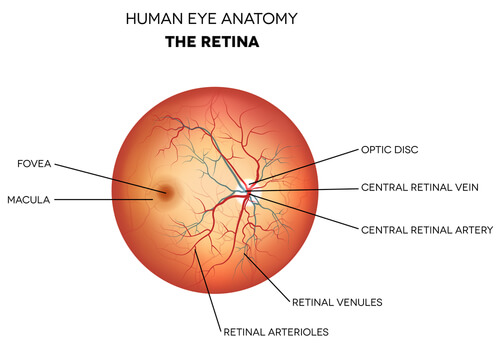
The eye is a marvelous organ that takes light and, in partnership with the nervous system, transforms it into a meaningful scene. It’s also very self-sufficient. It is self-focusing, self-adjusting, and self-cleaning. The job of focusing incoming light is occupied by the retina, which works closely with the brain, to allow us to see the faces of our loved one, beautiful vistas, and the pages of a good book.
The retina performs an enormous task. Not only is it translating light into meaning, it is acting as editor and curating, sifting out information and only processing what is useful for the viewer. The rest of the eye works diligently to focus the light rays that eventually make it to the retina.
The Retina Translates Light to Meaning
So what exactly do we mean when we say that the retina transforms light into meaningful scenes? Well, simply put, the retina converts light to nerve signals. Without this transformation, the light that is focused on the eyes would be useless for navigating and manipulating our environments. The retina is the reason we can see in different conditions and in such a dynamic way. Its connection to the brain is mediated via the optic nerve.
What Do the Rods and Cones in the Retina Do?
The retina is made up of highly specialized cells that can respond to light. There are two kinds: rods and cones. These two photoreceptors perform different tasks when it comes to dealing with incoming light.
Rods
The rods are sensitive to shape and movement and changes between light and dark. They only have one kind of light sensitive pigment so they are not very good for color vision. Their core purpose is to allow for vision in dim settings. There are approximately 120 million rods found in the human retina.
Cones
Cones are not as sensitive to light as rods are. This is why rods take on the task of helping us see in changing light conditions. Instead, cones are sensitive to specific colors. Each cone is sensitive to either green, red, or blue color signals. The signals are transmitted to the brain which can then give us the perception of color.
Cones only work in bright light. This is why it is hard to differentiate colors in the dark, even though you can still make out shapes and movement in dim lighting conditions. We use our cones to make out fine details. Cones also help us understand color blindness. Those who are color blind either don’t have a specific kind of cone (green, red, or blue) or have some cones that are weak.
Taking Care of Your Retinas
The biggest thing this mini lesson on the retina and retina function should do is impress upon you their importance and the importance of your eye health on the whole. Taking preventative steps is the best way to avoid damage and disease to your eyes. To avoid retinal conditions, it is recommended that you see your doctor for a routine eye exam every one to two years, wear sunglasses when out and about, eat healthy vitamin-A rich foods, and cut out smoking if you do.
To talk more about how you can make the best choices for your retinal health and your vision, stop by Washington Eye Physicians & Surgeons to speak with one of our ophthalmologists. You can schedule an appointment at our Chevy Chase location in the Washington DC area. Choose to take a proactive role towards your eye health!
© 2025 Washington Eye Physicians & Surgeons
The material contained on this site is for informational purposes only and is not intended to be a substitute for professional medical advice, diagnosis, or treatment. Always seek the advice of your physician or other qualified health care provider.